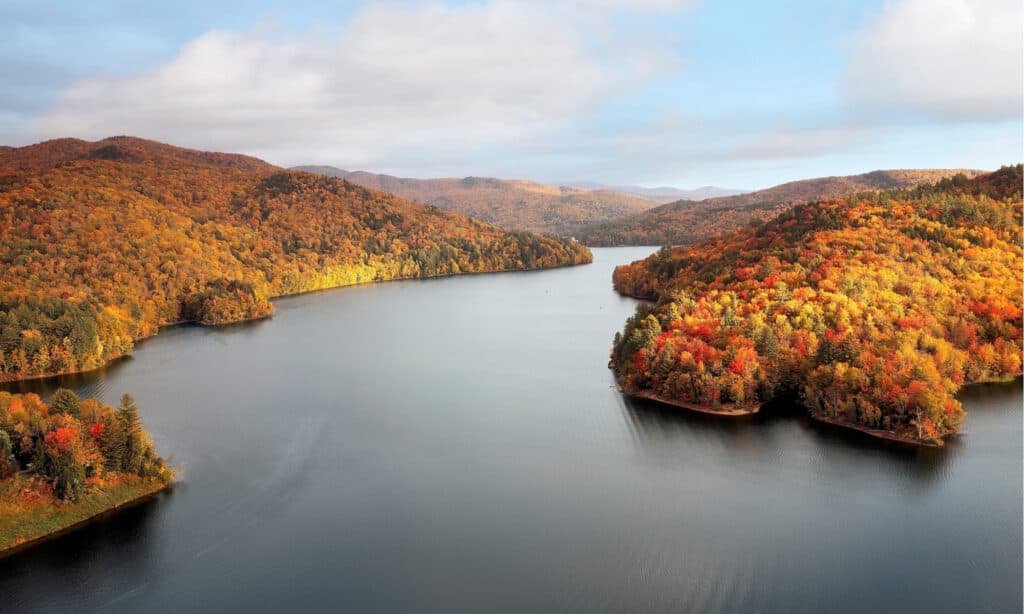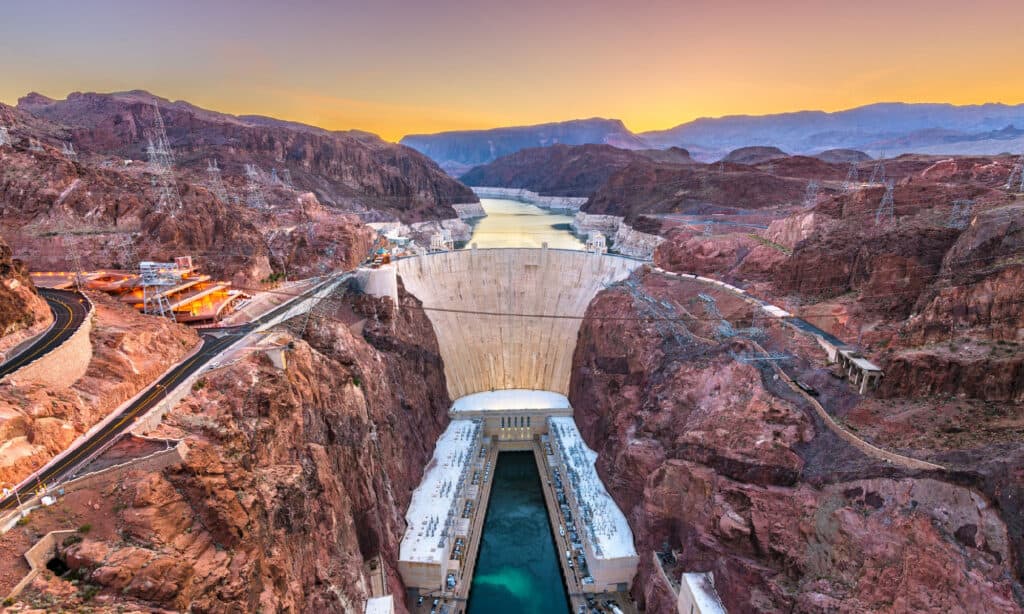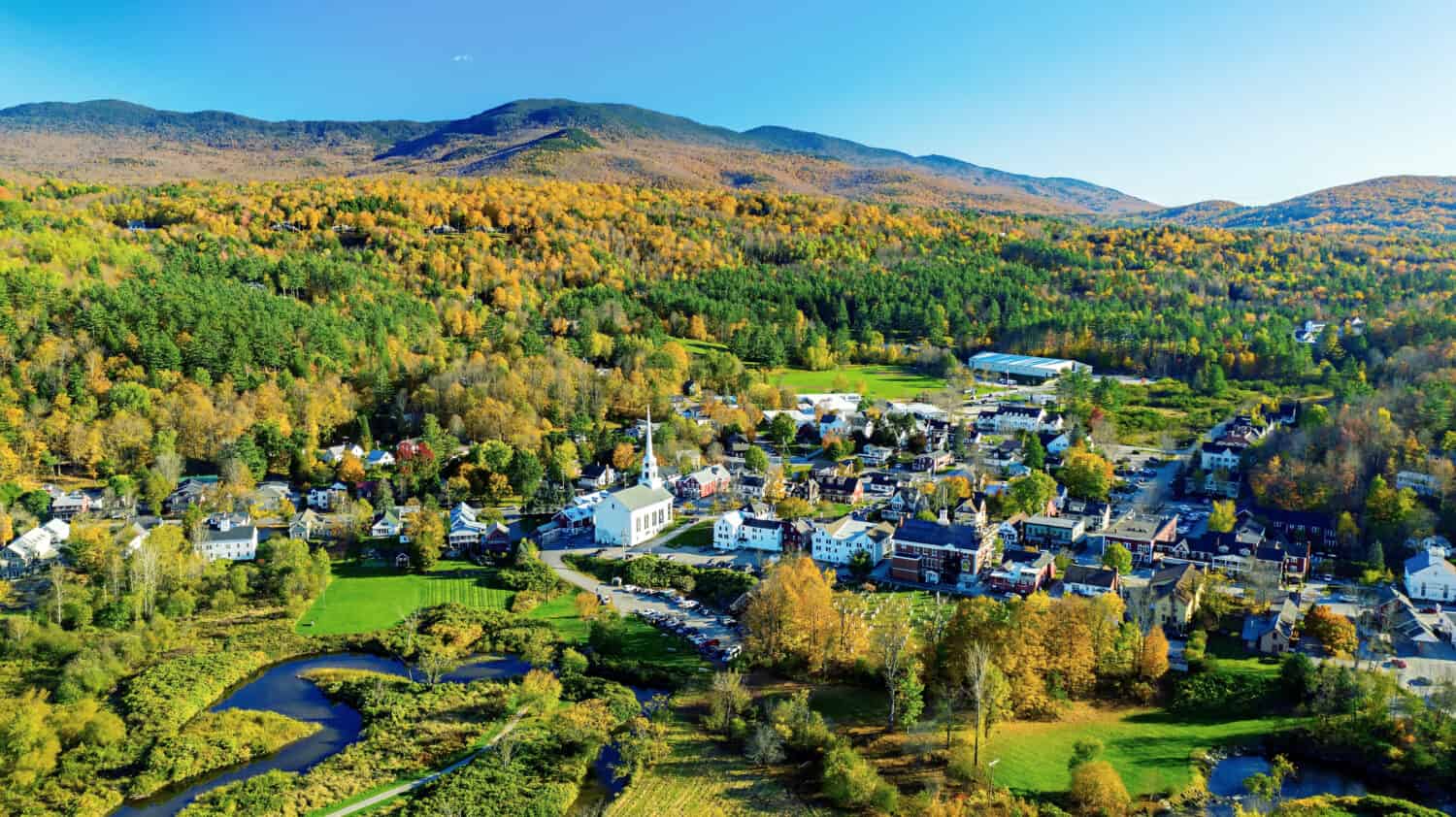
Vermont is a state in New England with a population of about 650,000 people. The state is famous for its beautiful remote areas, mountains, and ski towns. Although Vermont has few rivers, the ones it does have are very important for generating power and supplying water for the state’s residents. Today, we’re going to look at the largest dam in Vermont and show you how big it is, where it is located, and why it is so important to the area.
What Is the Largest Dam in Vermont?

The Waterbury Dam is an earthen embankment structure.
©John Couture/Shutterstock.com
The largest dam in Vermont is the Waterbury Dam, a dam that stands 187 feet tall and measures 2,130 feet long. The dam impounds the Little River and creates the Waterbury Reservoir. The Waterbury Reservoir is the ninth-largest body of water in Vermont. The reservoir has a surface area of 850 acres and a depth of about 100 feet, and it has a maximum capacity of about 9 billion gallons of water.
The primary part of the dam is an earthfill structure along with an 882-foot semicircular concrete structure. The government built the dam to control the flow of water in the Little River and Winooski River, and two others were made to control water in the same area.
Where Is the Waterbury Dam in Vermont?
The Waterbury Dam is located near Waterbury, Vermont. The dam is in Washington County, Vermont, a county that is located in the central-north part of the state. Waterbury Dam is located about 7 miles southwest of Stowe, a famous ski town in Vermont.
The Little River enters the Waterbury Reservoir from the north, and its flow is controlled by the Waterbury Dam. Some of the water is released to the south, and it continues to flow until it joins the Winooski River.
The Winooski River has a history of catastrophic floods, prompting the need for the construction of the Waterbury Dam. Even though a system of dams exists along the Little River and Winooski River, they still flood from time to time.
A History of the Waterbury Dam

The Little River State Park is on the coast of the Waterbury Reservoir.
©John Couture/Shutterstock.com
The Flood of ‘27 occurred between November 3 to 4, 1927. Heavy rain caused the Winooski River and others to reach over 10 feet higher than normal, inundating the area. Some 84 people died as a result of the flood, and the total damage exceeded $2.8 million in 1927 currency, worth hundreds of millions today.
The Civilian Conservation Corps, under the direction of the United States Army Corps of Engineers, started building the dam in 1935. Roughly 2,000 people took part in the dam’s construction. Waterbury Dam was built as part of the larger Winooski Flood Control Projects. The dam is made from 2,200,000 cubic yards of earth with impermeable clay at the center. The CCC finished the dam in 1938.
However, smaller updates to the dam structure followed. In June 1953, a hydroelectric power plant was built near the dam’s base. This structure is called the Little River Hydro Station, and it generates between 4.2 and 5.5 megawatts for the Green Mountain Power Corporation.
In 2011, the Waterbury area suffered a severe, damaging flood in the wake of Tropical Storm Irene. Although the Waterbury Dam held up, the storm highlighted the need to update the floodgate controls and spillway. The federal government supplied money for infrastructure projects, including some at the Waterbury Dam that will allow for the structure to continue to operate into the future.
What Animals Live Near the Waterbury Dam?

Black bears live in the area near the Waterbury Dam.
©Mark Caunt/Shutterstock.com
Many different animals live near the Waterbury Dam, both on land and in the reservoir. Let’s start by taking a look at the various animals that live on the land near the dam. Some of them are:
- American red squirrel
- Red fox
- Canada goose
- Common grackle
- American black bear
- Spotted salamander
- American beaver
- Painted turtle
- Garter snake
These animals thrive in Little River State Park and Waterbury Center State Park along with other places in the region.
The Waterbury Reservoir is home to a variety of fish species. Some of the most common ones in the area include:
- Yellow perch
- Smallmouth bass
- Brown trout
- Rainbow trout
Other species of fish and several different amphibians and reptiles also call this area home.
How Does the Largest Dam in Vermont Compare to the Biggest in the Country?

The Hoover Dam is the second-largest dam in the U.S.
©iStock.com/Sean Pavone
| Dam | Height | Length |
|---|---|---|
| Oroville Dam | 770 feet | 6,920 feet |
| Hoover Dam | 726 feet | 1,244 feet |
| Dworshak Dam | 717 feet | 3,287 feet |
| Glen Canyon Dam | 710 feet | 1,560 feet |
| Waterbury Dam | 187 feet | 2,130 feet |
Although the Waterbury Dam is the largest dam in Vermont, it is not the biggest one in the entire country. As the chart above shows, the Waterbury Dam is about a quarter of the height of the largest dam in the country, the Oroville Dam. Also, it’s less than a third of the total length of the Oroville Dam.
These statistics should not undercut the importance of this dam in anyone’s mind, though. The Waterbury Dam has stood since 1938, protecting the area from damaging floods. Even when the Winooski River has flooded since the dam’s construction, the presence of the Waterbury Dam has reduced the impact the floods could have had on the area.
For example, had this dam not been in place in 2011, the floods would have been far costlier and deadlier than they were. As it stands, 6 people died in Vermont, and many homes and businesses were damaged or outright destroyed.
All told the largest dam in Vermont is an architectural masterpiece because of the work required to create it and the impact the structure had on the area. Although the dam is not among the largest dams in the world, it has reduced the number and severity of floods in the region. The structure has certainly saved lives and livelihoods throughout its 8 decades of service.
Thank you for reading! Have some feedback for us? Contact the AZ Animals editorial team.








